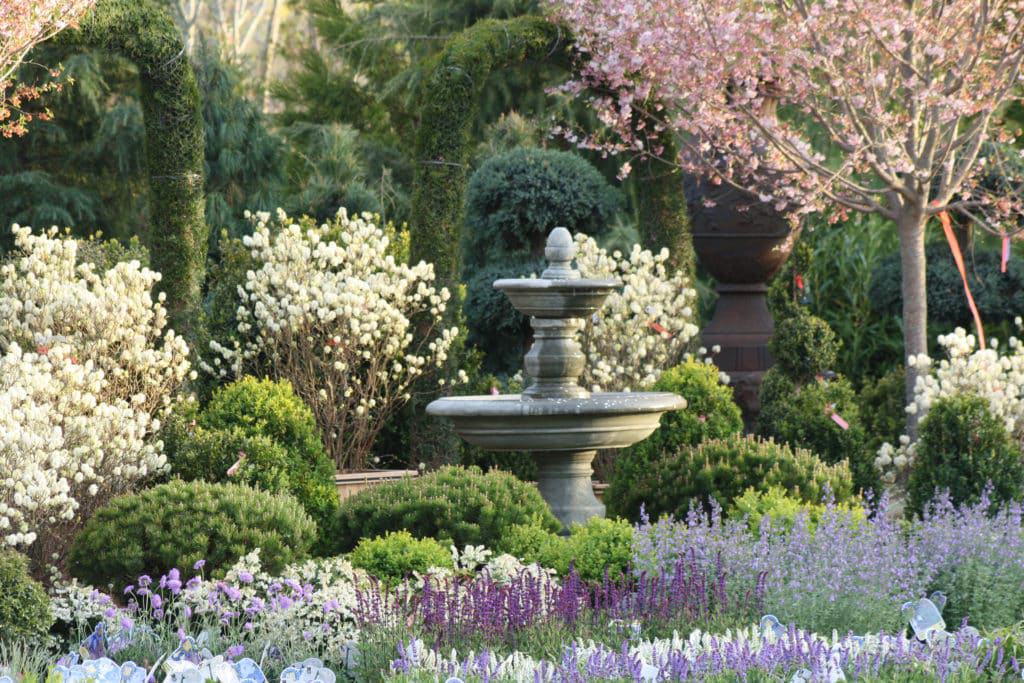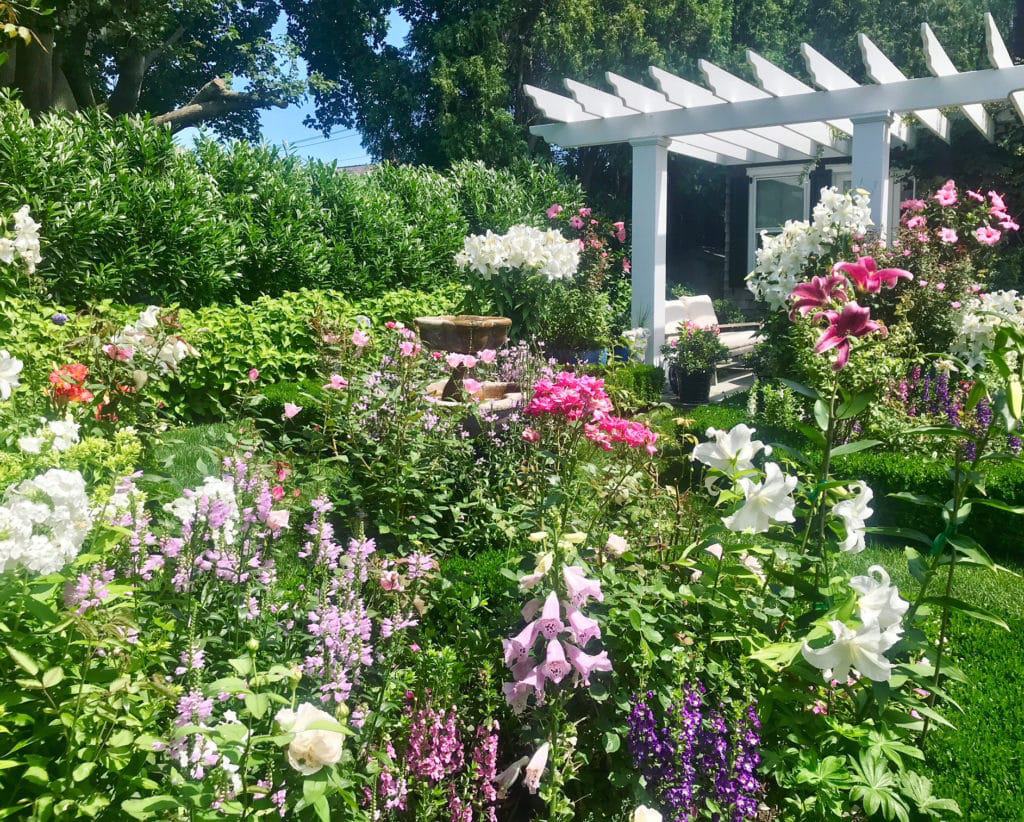In spring and summer flower gardens come back to life across the East End. Spring is the season of bulbs and perennials, and the earliest annual flowers. It begins with snowdrops, crocuses, pansies, daffodils and narcissus, and finishes with peonies, poppies and impatiens. Most perennial gardens reach their peak in late spring and early summer. Dianthus – garden pinks – are related to carnations, and their small clove-scented flowers are delightful. Perennial relatives of the geraniums that are stalwarts of summer pots and planters, called cranesbills for the shape of their long, narrow seedpods, grace the front of the spring garden with simple flowers in pretty shades of pink, purple, white and even blue. Airy, graceful coralbells, or heucheras, come into bloom in late spring, and most continue into midsummer. Their tall slender stems of tiny bell-shaped flowers in red, white or pink are carried above low mounds of rounded, ivy-shaped leaves which may be green, patterned, or purple and add color to the garden all summer. Irises and peonies are queens of the late spring garden. The best known are the bearded, Siberian and Japanese types, which bloom in shades of purple, pink, yellow, violet and white.

Peonies come in two forms – the most familiar is the herbaceous perennial kind that dies back to the ground in winter and sends out new stems each spring. The large single or double blossoms are showy and often sweetly fragrant, and come in many shades or red, rose and pink, as well as cream and white. Peonies are easy to grow, and in my garden (at least so far) not devoured by deer. If you are able to exclude deer from your flower garden, tulips should be part of it. There are thousands of cultivars and a tremendous selection of heights, colors and blooming times, and several different flower forms. Plant the bulbs in fall for a dazzling display in spring.
Spring-blooming shrubs such as forsythias, azaleas, rhododendrons, pieris and lilacs also add color to spring landscapes. Roses, too, begin to bloom in spring and by late spring rose gardens are filled with color and fragrance. Old garden roses, varieties that have been grown for centuries, are loved for their intoxicating fragrance. Newer varieties created by David Austin are also richly scented and easier to grow; many local nurseries carry them. Many roses will continue to bloom sporadically in summer, and some, such as the Knock Out varieties, will reward you with flowers all summer, if you can keep the deer out of your garden.

As spring turns into summer, the rosy reds and pinks of late spring peonies continue in roses and hollyhocks, along with the brilliant colors of annuals – yellow and orange marigolds, scarlet salvias, hot magenta or salmon impatiens. This is also the time for geraniums in a range of warm tones, and petunias in just about every shade of pink, red and purple, along with white and pale yellow. Deep blues are also in evidence. For example, blue salvias are wonderful companions for gold, white and melon-colored flowers. Annual bachelor’s buttons in their classic blue are delightful in bouquets and vases, where they seem to bring a bit of the summer sky indoors. And gardeners across the East End await the return of hydrangeas, the iconic Hamptons flower, later in the season.











!['The Maples' is a prestigious generational compound of two extraordinary estates: 18 Maple and 22 Maple. This rare offering, designed by luxury architect Lissoni partners New York and developed by visionaries Alessandro Zampedri-CFF Real Estate and JK Living, redefines opulence with the highest quality of craftsmanship and captivating views of the Atlantic Ocean. Represented by @nycsilversurfer and @challahbackgirl of @douglaselliman. [link in bio]](https://hamptonsrealestateshowcase.com/wp-content/uploads/sb-instagram-feed-images/438891010_1083749139481747_7890082604579275354_nfull.jpg)
![Featuring 360-degree water views on Mecox Bay, the Atlantic Ocean and Channel Pond, 1025 Flying Point offers the ultimate beach cottage that is flooded with natural light. With panoramic views, proximity to the ocean, and a private walkway to Mecox bay for kayaking or paddle boarding, this truly is a special retreat. Represented by @ritcheyhowe.realestate and @hollyhodderhamptons of @sothebysrealty. [link in bio]](https://hamptonsrealestateshowcase.com/wp-content/uploads/sb-instagram-feed-images/438994305_737511778456166_4602476013493875279_nfull.jpg)
![Attention advertisers! 📣 Secure your spot in the highly anticipated Memorial Day edition #HRES. Reach thousands of potential clients and showcase your brand in one of the most sought-after publications in the Hamptons, NYC, Palm Beach, and beyond. Contact us now to reserve your ad space! [link in bio]](https://hamptonsrealestateshowcase.com/wp-content/uploads/sb-instagram-feed-images/438549843_275102939023235_6718257301437562124_nfull.jpg)
![You eat with your eyes, and on the East End, it’s important that what you eat looks just as good as how it tastes. At @rosies.amagansett, the restaurant itself is plenty photo-worthy with blue ceramic tiling and yellow and white striped fabric wallpaper. But for a dish that will light up your photos, head directly to the salmon tartare! [link in bio]](https://hamptonsrealestateshowcase.com/wp-content/uploads/sb-instagram-feed-images/437094269_7296727147115953_1594410326824303644_nfull.jpg)

![We were honored to be the media sponsor for @blackmountaincapital's open house event with @jameskpeyton and @jfrangeskos at 11 Dering Lane in East Hampton! Other sponsors included @landrover, Feline Vodka, @rustikcakestudio, @la_parmigiana, @lahaciendamexicangrill11968, @homesteadwindows, Stone Castle, @talobuilders, and @thecorcorangroup.
A big thank you Carrie Brudner of Black Mountain Capital for putting together this fabulous event! [link in bio]](https://hamptonsrealestateshowcase.com/wp-content/uploads/sb-instagram-feed-images/437081213_762912965932136_6847332836522786568_nfull.jpg)

![Blooms Galore at the Long Island Tulip Festival! 🌷✨ Mark your calendars for April 15th as the vibrant tulips at @waterdrinkerlongisland burst into full bloom! Enjoy a day filled with colorful splendor, food trucks, live music, and more. [link in bio]](https://hamptonsrealestateshowcase.com/wp-content/uploads/sb-instagram-feed-images/437083429_974242677583725_6855805712693638343_nfull.jpg)
